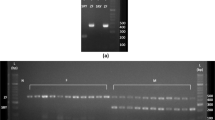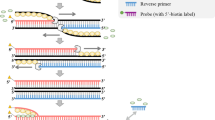Abstract
We describe a quick and efficient method of determining the sex of DNA samples from humans, cattle, sheep, and goats. Using universal primers we have amplified 447 or 445 bp fragments from male or female genomic DNA corresponding to the ZFY or ZFX genes. Restriction fragment length polymorphism (RFLP) analysis of the fragments yielded specific banding patterns between the two sexes in these species. Horse, pig and rainbow trout fragments did not show RFLPs with the group of enzymes chosen for the other species. Use of this method would allow animal breeders to determine the sex of preimplantation embryos before transfer to recipient females. Human embryos at risk for sex-linked disorders could be sexed soon after in vitro fertilization (IVF) and options considered before implantation.
This is a preview of subscription content, access via your institution
Access options
Subscribe to this journal
Receive 12 print issues and online access
$209.00 per year
only $17.42 per issue
Buy this article
- Purchase on Springer Link
- Instant access to full article PDF
Prices may be subject to local taxes which are calculated during checkout
Similar content being viewed by others
References
Woolliams, J.A. and Wilmut, I. 1989. Embryo manipulation in cattle breeding and production. Animal Production 48: 3–30.
King, W.A. 1984. Sexing embryos by cytological methods. Theriogenology 5: 243–253.
Kogan, S.C., Doherty, M. and Gitschier, J. 1987. An improved method for prenatal diagnosis of genetic diseases by analysis of amplified DNA sequences. N Engl. J. Med. 317: 985–990.
Ebensperger, C., Studer, R. and Epplen, J.T. 1989. Specific amplification of the ZFY gene to screen sex in man. Human Genetics 82: 289–290.
Herr, C.M., Holt, N.A., Matthaei, K.I. and Reed, K.C. 1990. Sex of progeny from bovine embryos sexed with a rapid Y-chromosome detecting assay. Theriogenology 33: 245–247.
Page, D.C., Moster, R., Simpson, E.M., Fisher, E.M., Mardon, G., Pollack, J., McGilluray, B., de la Chapelle, A. and Brown, L.G. 1987. The sex-determining region of the human Y chromosome encodes a finger protein. Cell 51: 1091–1104.
Schneider-Gädicke, A., Beer-Romero, P., Brown, L.G., Nussbaum, R. and Page, D.C. 1989. ZFX has a gene structure similar to ZFY, the putative human sex determinant, and escapes X inactivation. Cell 57: 1247–1258.
Mardon, G., Mosher, R., Disteche, C.M., Nishioke, Y., McLaren, A. and Page, D.C. 1989. Duplication, deletion, and polymorphism in the sex-determining region of the mouse Y chromosome. Science 243: 78–80.
Nagamine, C.M., Kaimin, C., Kozak, C.A. and Lau, Y.F. 1989. Chromosome mapping and expression of a putative testis-determin-ing gene in mouse. Science 243: 80–83.
Koopman, P., Gubbay, J., Collignon, J. and Badge-Lovell, R. 1989. Zfy gene expression patterns are not compatible with a primary role in mouse sex determination. Nature 342: 940–942.
Palmer, M.S., Sinclair, A.H., Berta, P., Ellis, N.A., Goodfellow, P.N., Abbas, N.E. and Fellous, M. 1989. Genetic evidence that ZFY is not the testis-determining factor. Nature 342: 937–939.
Southern, E.M. 1975. Detection of specific sequences among DNA fragments separated by gel electrophoresis. J. Mol. Biol. 98: 503–517.
Handyside, A.H., Kontogianni, E.H., Hardy, K. and Winston, R.M.L. 1990. Pregnancies from biopsied human preimplantation embryos sexed by Y-specific DNA amplification. Nature 344: 768–770.
Medrano, J.F. and Aguilar-Cordova, E. 1990. Genotyping of bovine kappa-casein loci following DNA sequence amplification. Bio/Technology 8: 144–146.
Medrano, J.F. and Aguilar-Cordova, E. 1990. Polymerase chain reaction amplification of bovine β-lactoglobulin genomic sequences and identification of genetic variants by RFLP analysis. Animal Biotechnology 1: 73–77.
McKusick, V.A. 1988. Mendelian inheritance in man: Catalogs of autosomal dominant, autosomal recessive, and X-linked phenotypes, 8th ed. Johns Hopkins University Press, Baltimore, MD.
Madisen, L., Hoar, D.I., Holroyd, C.D., Crisp, M. and Hodes, M.E. 1987. DNA banking: the effects of storage of blood and isolated DNA on the integrity of DNA. Am. J. Med. Genetics 27: 379–390.
Ashworth, A., Swift, S. and Affara, N. 1989. Sequence of cDNA for murine Zfy-1, a candidate for Tdy. Nucleic Acids Res. 17: 2864.
Mardon, G. and Page, D.C. 1989. The sex-determining region of the mouse Y chromosome encodes a protein with a highly acidic domain and 13 zinc fingers. Cell 56: 765–770.
Maniatis, T., Fritsch, E.F. and Sambrook, J. 1982. Molecular Cloning: A Laboratory Manual. Cold Spring Harbor Laboratory, New York.
Author information
Authors and Affiliations
Rights and permissions
About this article
Cite this article
Aasen, E., Medrano, J. Amplification of the Zfy and Zfx Genes for Sex Identification in Humans, Cattle, Sheep and Goats. Nat Biotechnol 8, 1279–1281 (1990). https://doi.org/10.1038/nbt1290-1279
Received:
Accepted:
Issue Date:
DOI: https://doi.org/10.1038/nbt1290-1279
This article is cited by
-
A reduced SNP panel optimised for non-invasive genetic assessment of a genetically impoverished conservation icon, the European bison
Scientific Reports (2024)
-
Gender disparity in survival of early porcine fetuses due to altered androgen receptor or associated U2 spliceosome component
Scientific Reports (2023)
-
Development of a microhaplotype panel to inform management of gray wolves
Conservation Genetics Resources (2023)
-
Porcine Primordial Germ Cell-Like Cells Generated from Induced Pluripotent Stem Cells Under Different Culture Conditions
Stem Cell Reviews and Reports (2022)
-
Molecular sexing of Xenarthra: a tool for genetic and ecological studies
Conservation Genetics Resources (2021)



